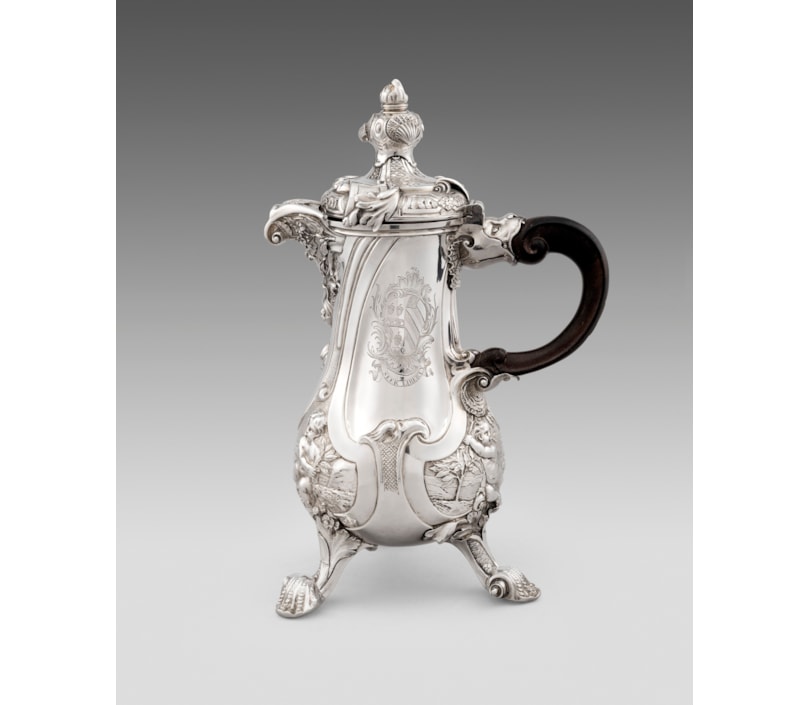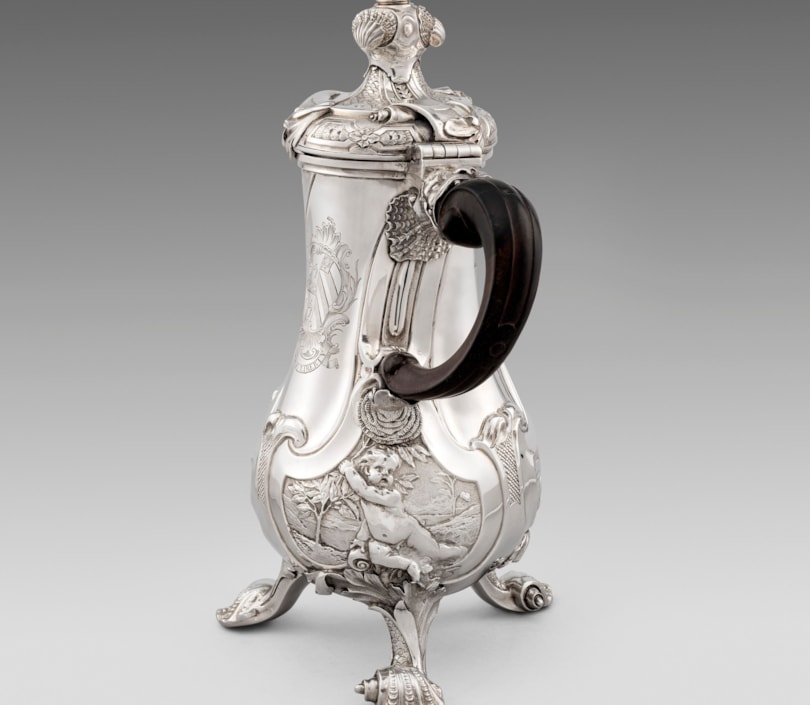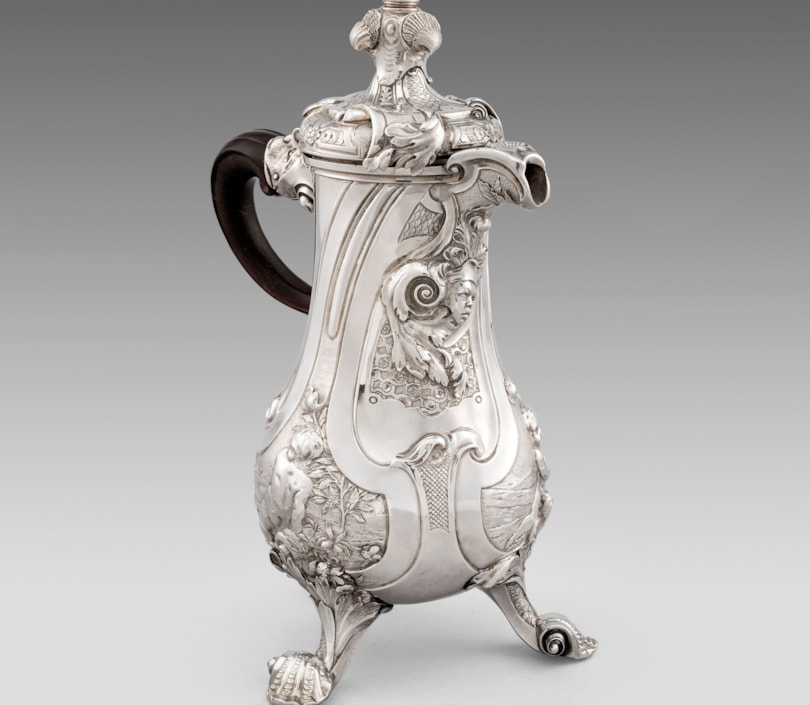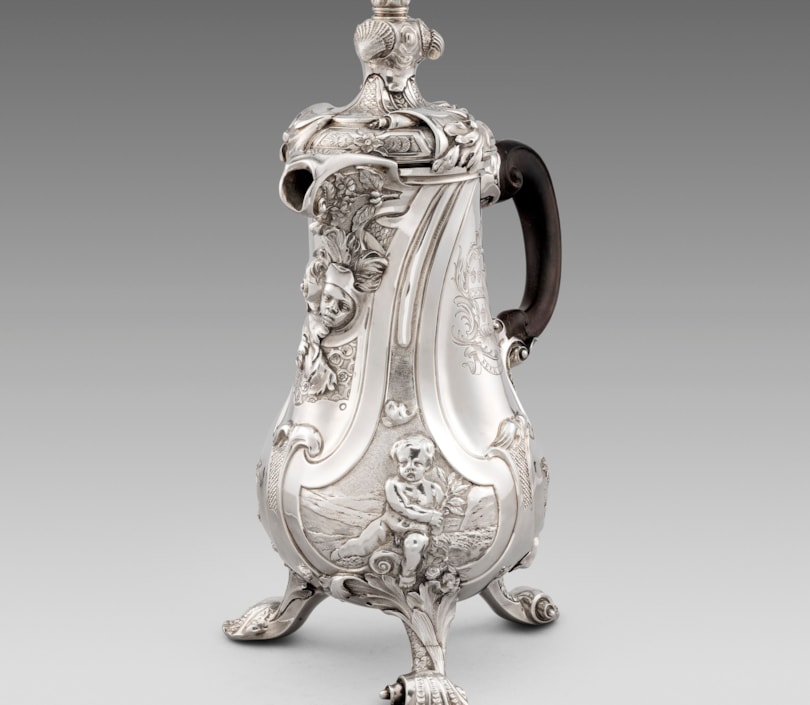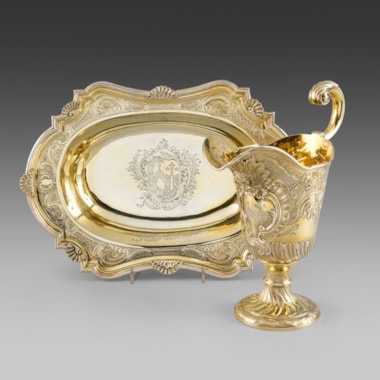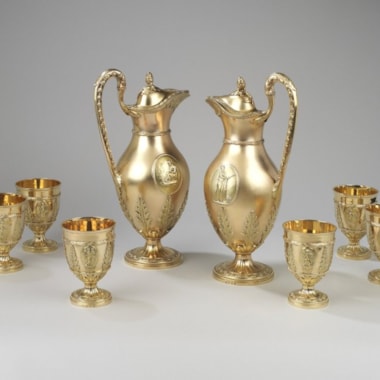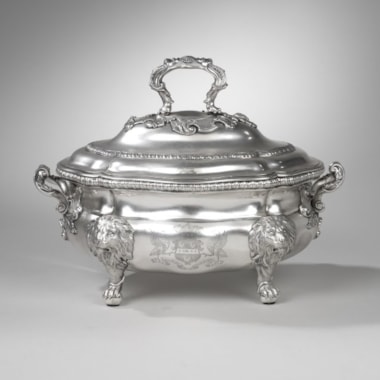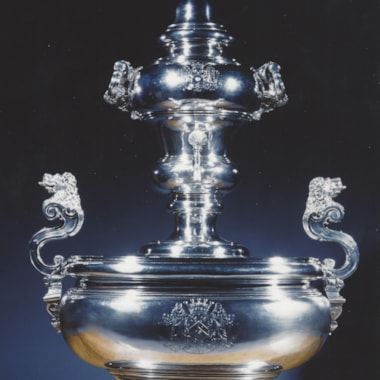The spirally-fluted pear-shaped body on three shell and acanthus foliage and a flower-capped scroll feet, cast and chased above each foot with panel depicting a putto at rest within a landscape, two clasping coffee bush branches, with matting above, finely cast and chased beneath the short shell-capped spout with a mask emerging from coffee bush branches and flowers and with scrolls and rosette trellis, with two bird's head and scroll cartouches, one engraved with a coat-of arms within engraved foliate scrolls and rocaille, the hinged waisted cover chased with panels of flowers on a matted ground, separated by applied panelled scrolls and acanthus foliage, the flame-form finial cast and chased with three shells above chased scrolls, the carved wood handle set asymmetrically to the body and with a lion-mask upper terminal and a foliage cast lower terminal, marked underneath and on the cover bezel.
The asymmetrical swirling form of the Lequesne coffee-pot is a masterpiece of the English rococo. When exhibited as part of the ground breaking Treasure Houses of Britain exhibition in Washington in 1985, the coffee- pot was described by Judith Banister in the catalogue entry as 'unparalleled in its virtuosity, revealing the great goldsmith Paul de Lamerie at his most inventive and skilful’, she went on to comment that it was 'one of the finest and most original examples of English silversmithing'. These quotes encapsulate the qualities of the piece which collectors and academics alike have admired for many years.
Philippa Granville noted in M. Snodin, op. cit, p. 109 that the overall feet form of the coffee-pot with its pear-shaped body supported executed on three scrolling feet ultimately derived from the design for a coffee-pot executed for King Louis XIV of France in 1703, illustrated in C. Hernmarck, The Art of the European Silversmith, London, 1978, pl. 340. French coffee pots with the spirally fluted bodies from around this date survive, however, none show the originality of design and exuberance of decoration displayed by the Lequesne coffeepot where ornament has become form and form ornament. There are four coffee pots by de Lamerie whose shape and decoration relate to the Lequesne pot. One of 1737 is in the collection of the Metropolitan Museum in New York and a similar pot of 1743, but with a stand a lamp, in is the Gilbert Collection, the Victoria and Albert Museum, illustrated in T. Schroder, op. cit., p. 269. Two date from 1738, the year of the Lequesne coffee-pot; one is in the Folger Collection, illustrated in the 1990 Goldsmiths' Hall exhibition catalogue, op. cit., no. 101, and another is the in the Sterling and Francine Clarke Institute collection (see B. Carver Wees, op. cit, p. 301). All four share the same pear-shaped body and three have similar putti, finials, coffee bush foliage, shells and scrolls; each have varying levels of ornament, featuring putti, however, none match the Lequesne coffee-pot's sophistication and originality of design.
The Lequesne coffee-pot is set apart from these four by the origin of its design and the three dimensionality of its ornament - both real and illusionary. The bold modelling of the exotic putto mask and coffee bush foliage beneath the rim, the shell and flame finial and the lion's mask handle terminal are balanced by the illusion of depth achieved by the masterful modelling and chasing in light relief of the three shaped panels enclosing scenes depicting putti clasping coffee bush sprays; two putti face the viewer and one with his back turned looks away. The sinuous spiral curve of the pot, highlighted by the scroll sided cartouches, is further emphasised by the unique and extraordinary asymmetrical handle which curves away from the lower handle junction to be seemingly swallowed by a yawning lion's mask forming the upper junction. The cover appears to be clasped by three acanthus-wrapped scrolls with the tips of the foliage extending over the rim. No areas are strictly defined; ornament bursts across boundaries overlaying conventional panels of rosette trellis, scalework and matting. The impression is of the form being subsumed by the ornament
These extraordinary qualities can also be seen to varying degrees in some of Lamerie's finest commissions of the period, such as the Mountrath ewer and basin of 1742, the Goldsmiths' Company ewer and basin of 1741 and the llchester ewer and basin of circa 1740. In recent years a theory has been put forward that the exceptional qualities of the design and modelling of these pieces relate to a particular craftsman in the Lamerie workshop, now known as the Maynard modeller; so called because the evidence of his existence first appears in the cast ornament found on the Maynard sideboard dish of 1736, now in the celebrated Cahn collection of Paul de Lamerie silver, illustrated in E. Alcorn, Beyond the Maker's Mark, Paul de Lamerie Silver in the Cahn Collection, Cambridge, 2006, no. 27. She observes that 'His compositions are sophisticated, weaving earthy, abstract imagery and naturalism around figural scenes.’
His work has exquisite detail with whimsical almost comical touches, such as ‘the sleepy lions’ mask which holds the handle of the Lequesne coffeepot. Putti with dimpled limbs and high foreheads and deep scrolls are similarly leitmotifs of his work. Ubaldo Vitali in his paper ‘Retooling the Rococo’, delivered at the Virginia Museum for the Fine Arts symposium Rococo Silver in England and its Colonies, 2004, suggests he was a chaser working with wax or wooden models from which the silver elements would have been cast using the lost wax process. A clue to the identity of this mysterious figure was uncovered by Maureen Cassidy-Geiger during research for her paper ‘Quelque chose de beau et den bon goὕt’: a silver-gilt toilet service for Dresden Doppelhochzeit of 1747’ also delivered at the 2004 Virginia Museum symposium. Parallels were drawn to the work of the Kἂndler family of Dresden, although the discussion continues.
SIR JOHN LEQUESNE (1687-1741)
There were many members of the Church of Rouen who sacrificed, as this faithful Confessor had, their goods for their freedom, who gave money to obtain Passports from the Intendants These Gentlemen did not have great scruples about betraying the intentions of his Majesty for their own profit.’
Pierre had indeed sent his two sons abroad. At the time of their father's deoth lohn and David (1691-1754) were in London in the care of a merchant Francis Beuzelin Spanish (d. 1733) of leadenhall Street. The teenage John and his younger brother David remained in london as John was apprenticed to Robert Briscoe of the Grocers Company on 1 January 1701 for the usual period of seven years. (London Metropolitan Archive, Freedom of the City Admission Papers; Ref. No. COL/CHD/FR/02/0260 0265). He appears to have prospered after completing his apprenticeship. He and his brother David were in business by 1721 as suggested by a court se registered in 1721 between John and David lequesne 'merchants and c partners of London' and a Richard Bower (Public Record Office Mss C 11/1993/20). By 1724 John is listed being in business on Broad Street London Metropolitan Archive, Land Tax Records, 1724, MS 11316/75.) where his brother was to join him and continue the business after his death in 1741. It is probable that John and David Lequesne traded with the West Indes; The Calendar of State Papers, (Ms. C.O. 388, 24, No. 150) include a document submited by John and David in May 1724 relating to duty on the sugar and tobacco trade.
Sir John died in 1741 and was buried in St. Peter le Poer, the church in hich he was married and his daughter baptized. There remains no record of his will, however his estate was administered by his widow, who later became Lady luxborough and then Countess of Catherlough having married Robert Knight (1702-1772], 1st Baron luxborough and Ist Earl Catherlough as his second wife in 1756. At the time of their marriage she was living on Bruton Street, Mayfair. The marriage was childless and probably an unhappy one; Catherlough took the daughter of one of his tenants as a mistress in the 1760s fathering at least four children by her. After his death in 1772 lady Catherlough lived in Hampton, Middlesex dying there in 1795. The history of the coffee pot after the death of Sir John in 1741 and it reappearance at auction in 1929 remains a mystery. It is probable that it was left together with the kettle, stand, lamp and salver, also by de Lamerie, which is now in the Gilbert Collection, the Victoria and Albert Mto his widow (see opposite). Presumably she was able to retain the ene silver following her husband's death in 1772. Her will of 1795 (Fublic Record Office, Mss. PROB 11/1268/120) contains numerous monetary bequests to friends and godchildren confirming she was still a woman of considerable wealth at the time of her death. There is no specific mention of silver beyond 'I give and the bequeath all my household goods ffurniture [sic] plate linen and china unto id Miss Rand and all the rest of my personal estate'. Earlier in the will Miss Rand is described as Miss Mary Rand of Hampton.
COFFEE -A NEW FASHION of the English he first London coffee house was opened by a former in servant 1652. Pasqua Levant Company, which traded with Constantinople, and had acquired a taste for the Rosée had served in Smyrna (now Izmir) and by the early years of the dark stimulant drink. The fashion took hold houses in London. The 18th century there was an estimated 3,000 coffee extolled by printed drink's many virtues, both real and imagined, were consumed too late. Each handbills; they also warned of a sleepless night if coffee house had its own particular clientele, some were literary, som political, others concerned with shipping and others institutions finance. From such the as the coffee house came the Gentleman's Clubs and City insurance market of by loyds the establishment; of london. These King unofficial Charles II meeting tried to places censure of were them whom disapproved in 1675, to no avail. Equally disapproving were women, a group published The Women's Petition Against Coffee in 1674 By the early 18th century the practice had acquireo eptance was and coffee was being consumed at home from silver andn pots. It usually served black and from long spouted vessels. There was also the fashion for taking it in the Turkish manner, with large quantities of sugar syrup used in the preparation. Contemporary accounts in the business ledgers of the silversmith George Wickes survive for 'Turky Coffee Pots with short spouts, cited by B. Carver Wees, op. cit., p. 300., and as used by Lamerie for the lequesne coffee pot., the short spout meant viscous liquid flowed freely. The use of the lequesne pot is left in not doubt by the putti which perch above the scroll feet each clasping a branch from the coffee bush
Sir John Lequesne Kt. (1687-1741), presumably then to his widow,
Mary, Lady Lequesne, later Countess of Catherlough (d. 1795), possibly left as part of her plate to her goddaughter Miss Mary Rand of Hampton, Middlesex.
John Gabbitas (1853-1940), Weston Lodge, Weston-under-Penyard, Herefordshire
Mr.J. Gabbitas; Sotheby's, London, 27 June 1929, lot 171.
Mrs Anna Thomson Dodge (1871-1970).
The late Mrs Anna Thompson Dodge; Christie's London, 23 June 1971, lot 24.
A European Collector; Christie's, New York, 5 October 1983, lot 207.
A. Grimwade, Rococo Silver 1727-1765, London, 1974, p. 51, pl. 60A.
G. Norman, 'Silver Coffee Pot Fetches an Auction Record', The Times, 7 October 1983, p. 16.
M. Snodin, ed., Rococo: Art and Design in Hogarth's England, London, 1984, pp.109
M. Clayton, Christie's Review of the Season, 1984, p. 329,
M. Clayton, Christie's Pictorial History of English and American Silver, Oxford, 1985, p. 138, no. 721 G. Jackson-Stops, ed., The Treasure Houses of Britain, Yale, 1985, pp. 515 516
V. Brett, The Sotheby's Directory of Silver, London, 1986, p. 177, no. 721
T. Schroder, The Gilbert Collection of Gold and Silver, Los Angeles, 1988, p. 233
The Glory of the Goldsmith, Magnificent Gold and Silver from the Al Tajir Collection, 1989, pp. 108-109, no. 77
Paul de Lamerie, The Work of England's Master Silversmith (1688-1751), London, 1990, p. 131.
B. Carver Wees, English and Scottish Silver at the Sterling and Francine Clarke Art Institute, New York, 1997, p. 300
You May Also Like



































































